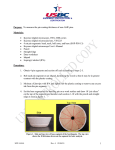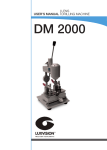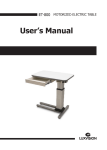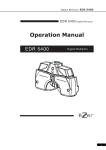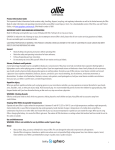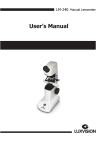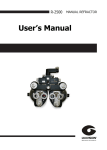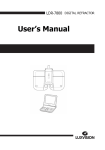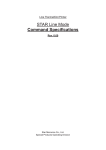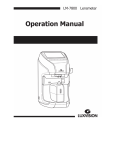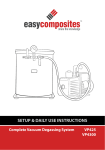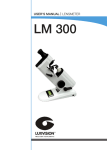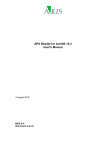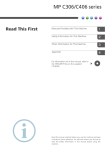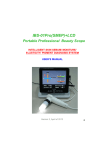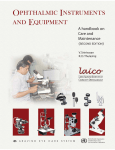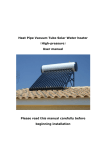Download User Manual
Transcript
Notification Dear Users, Thank you for your purchase of LM 220 Lensmeter. Please take time to read our user’s manual carefully before use. This guarantees you to make full use of this unit and prolongs the operation life of this unit. Precautions If you have detected abnormal heat, smoke, noise or smell, immediately stop using the product. In the event of an abnormality, turn off the power and disconnect the power plug from the power socket. Continuing to use the product may result in electric shock or fire. Observe the instructions given below regarding the power cable: • • • • • • Be sure to use the supplied or specified power cable. Do not modify, forcibly bend, kink or pull the power cable. When disconnecting the power cable from the AC outlet, be sure to hold the cable by the plug. Pulling the cable may cause wire breakage or shot circuit, resulting in fire or electric shock. Do not connect or disconnect the plug of the power cable to/from the AC outlet using wet hands. Doing so may result in electric shock. Do not touch the product with wet hands while the power cable is connected to the AC outlet. Doing so may result in electric shock. If the product will not be used for a long period, disconnect the power cable from the power source. Leaving the cable connected to the power socket for a prolonged period will consume electricity and may result in heating. Content 1. Function Introduction .....................................................................................4 2. Working Principle Device ................................................................................4 3. Functions ......................................................................................................5 4. Operation ....................................................................................................15 5. Maintenance ................................................................................................22 6. Common Trouble Shooting ...........................................................................23 7. Specifications ..............................................................................................24 1. Function Introduction This lens meter is divided into 2 models, standard model and strengthened model with prism compensator. This product is applicable to measurement testing departments, spectacles manufacturers, retail dealers of spectacles, hospital’s department of ophthalmology and optical element factories for conducting measurement of spherical lens diopter, cylindrical lens diopter, cylindrical lens axis of astigmatism, prism diopter, prism basal angle and cornea contact lens diopter. In the following description, all chapters or content attached with “ * “ in the front are special for strengthened model device with prism compensator. 2. Working Principle of Device Fig. 1 Diagram of Optical Principie of Device 1. Light source 4. Measuring object lens 7. Half 5-edge prism 10. Prism compensator 2. Color filterpiece 5. Diaphragm 8. Eyepiece dividing píate 3. Mark dividing plate 6. Telescope objective 9. Eyepiece set * This device consists of a coaxial optical system. The light emitted from light source 1 (illuminating lamp) passes through color filter piece 2 and lights up mark dividing plate 3. Then mark dividing plate 3, through measuring object lens 4 and telescope objective 6, and after turning direction through half 5-edge prism 7, is imaged at eyepiece dividing plate 8. At this time, through eyepiece set 9, it is possible for human eyes to observe clear images of mark dividing plate 3 and eyepiece dividing plate 8. 4 During operation, place the spectacle lens at diaphragm 5 (measurement bearing seat). Turn diopter measuring hand-wheel and astigmatism axis measuring hand-wheel to obtain a clear image of mark dividing plate 3. Now, the scale value on the diopter measuring hand-wheel linked with mark dividing plate 3 is just the diopter reading of the said lens. 3. Functions First, please take a little time to have a look at picture and illustration on following 11 pages and get familiar with your device. 3.1 Viewed from front side 1. Top cover *10. Prism compensator 2. Eyepiece system 6. Printing mechanism 3. Lens pressing mechanism 7. Lens pushing mechanism 4. Measurement bearing seat 8. Diopter measuring hand-wheel 5.Astigmatism measuring axis hand-wheel 9. Mains switch Fig. 2 5 3.1.1 Top cover (Fig.3) It is an arch-shape cover plate that can be dismantled, which offers a window for professional personnel to maintain the device. Top cover Fig. 3 For non-professional personnel, please do not open the top cover by yourself, and do not move internal parts either. Warning When moving the device, it is strictly forbidden to hold the top cover so as to avoid damage to the device (Fig.4). Correct way of moving the device: Put one hand on body of device and hold its bottom with other hand. Fig. 4 6 3.1.2 Eyepiece system (Fig.5) The eyepiece system is a screw-type focusing unit with focusing range of ± 5D to be adapted to different eyesight of human. Eyepiece lens Scale of eyepiece focusing range Fig. 5 3.1.3 Lens pressing mechanism (Fig.6) In this mechanism, 3 plastic pressing feet with spring are used to press lens, where, lens with any shape of surface can be firmly pressed without damage to lens surface. In use, lift the lens-pressing handle so that the lens pressing mechanism is lowered to press the lens. After use, lift the lens-pressing handle to hang up the lens pressing mechanism. Lens pressing handle Lens pressing feet (3 pieces) Fig. 6 7 3.1.4 Measurement bearing seat (see Fig.7) It is a white nylon part that is able to firmly support lens with any shape of surface without damage to lens surface. Below it is measuring eyepiece with 3 lock screws beside it. When the device is not used, it shall be covered with a dust cap made of black rubber to protect measuring eyepiece from dirtying the measuring eyepiece (see Fig.8). When using device for measurement, take off the dust cap. Lock screw (3 pieces) Measurement bearing seat Fig. 7 Dust cap Fig. 8 8 3.1.5 Astigmatism axis measuring hand-wheel (see Fig. 9) It is used to measure and locate astigmatism axis angle of cylindrical lens and basal angle of prism. It is identical to graduated disc of eyepiece dividing plate, whose scale range is 0 ~ 180° and scale spacing 5°. Pointer of astigmatism axis measurement Scale of astigmatism axis angle measurement Hand-wheel of astigmatism axis measurement Fig. 9 3.1.6 Printing mechanism (see Fig.10) This mechanism consists of a point-making pen supporter, a point-making handle, 3 similar point-making pens connected in a line, and an inkpad box. Here, the pen in the middle is used to mark lens center, the connected point line printed by 3 pens is used to calibrate astigmatism axis angle of lens and basal angle of prism lens, and inkpad box used to store printing ink. When printing is required, turn the point-making handle, then ink is easily and quickly printed on the lens. Point-making handle Point-making pen (3 pieces) Point-making pen supporter Inkpad box Fig. 9 9 3.1.7 Lens pushing mechanism (see Fig.11 and Fig.12) This mechanism consists of lens pushing handle, lens pushing plate, lens pushing pointer and lens pushing measuring scale (scale range of measuring scale is 26 cm ~ 84 cm), used to position lens and measure diameter of lens. When using it, turn downward the lens-pushing handle, then the lens pushing plate is pushed out forward. After use, turn upward the lens-pushing handle, then the lens pushing plate draws back. When measurement is needed, first press lens with lens pressing mechanism, then lightly move lens so as to align it, and fix it by lens pushing mechanism. Now it is possible to read size of the measured lens and conduct other measurement. Lens pushing handle Lens pushing plate Fig. 11 Lens pushing pointer Lens pushing measuring scale Fig. 12 10 3.1.8 Diopter measuring hand-wheel (see Fig. 13) It can be rotated smoothly and stably. Druing measurement, rotate the handwheel to have a clear focusing, according to the indication of guiding line,degree of lens can be read. Reading pointer Hand-wheel rubber ring Diopter measuring hand-wheel Graduated disc Fig. 13 3.1.9 Mains switch Please refer to Fig.2. *3.1.10 Prism compensator (see Fig. 14) MODEL LM 220 P When prism diopter to be measured is bigger than 5∆, use of prism compensator is necessary. There are 2 lines of scale on the prism compensator: the upperline denotes angle, whose scale range is 0° ~ 180°, with minimum scale value of 5°; the lower line is prism diopter, whose scale range is 15∆ ~ 0 ~ 15∆. Prism degree measuring hand-wheel Basal angle graduation Reading pointer Fig. 14 Prism degree graduation 11 3.2 Viewed from Eyepiece Set (see Fig.15) When viewing through eyepiece set to inside of device, one can see eyepiece dividing plate and image of mark dividing plate. 1. Eyepiece dividing plate 2. Image of mark dividing plate Fig. 15 Illustration of eyepiece dividing plate, image of mark dividing plate and reading window is shown as follows. 3.2.1 Eyepiece dividing plate (see Fig.16) Prism degree measuring scale and graduated disc are marked on the eyepiece dividing plate. Integer prism degree can be read directly from the measuring scale, and decimal fraction prism degree is read by estimation of measuring scale. Scale range of graduated disc is 0° ~ 180°, with scale spacing of 1°. 12 1. Eyepiece dividing plate 2. Image of mark dividing plate Fig. 16 3.2.2 Image of mark dividing plate (see Fig.15) Image of mark dividing plate is composed of 3 horizontal long green lines (cylindrical marking lines), 2 vertical long green lines (spherical marking Unes), 9 small round points in the center and a ring consisting of 12 small round points. Spherical marking line Cylindrical marking line 9 small round points Ring consisting of 12 small round points Fig. 17 13 3.3 Viewed from Bottom (Fig.18) 3.3.1 Bottom structure It consists of a cover plate with 9 heat elimination holes and 4 rubber feet, where, the rubber feet are connected to base seat with M4 hexagonal round head screws. Heat elimination hole Rubber feet (4 pieces) Fig. 18 3.3.2 Replacement of lamp (Fig. 18 and Fig. 19) Procedure of replacing lamp is shown as follows: A. Pull out power source plug, keep it cooling for 10 to 15 minutes to avoid scald. B. Lay down backwards the device so that it is smoothly paced on working table. C. Loosen 4 screws with hexagonal wrench, take off the rubber feet and then take out the coverplate. D. Take off the old lamp and put on the new one. E. Put on the cover plate and rubber feet, and tighten 4 screws. Lamp Lamp seat Wiring terminal Fig. 19 14 Matters Needing Attention Please replace it with a new lamp whose model is similar to the original one so as to prevent center of light source from deviating optical axis of device that has an effect on normal measurement of device. 4. Operation 4.1 Preparation Before Measurement 4.1.1 Take off dust cap and put device on working table (the working table shall have a proper height to the extent that the measuring person feels comfortable). 4.1.2 Switch on power. 4.1.3 Adjustment of eyepiece vision: To achieve an accurate and reliable measurement result, adjustment of eyepiece vision shall be conducted before measurement. The method: Observe black digit on the eyepiece dividing plate in the eyepiece view field while turning the eyepiece cap until the black digit becomes clearest. Matters Needing Attention It is advisable to turn eyepiece cap in one-way direction because it can eliminate influence brought up by the effect of eye adjustment. 4.1.4 Zero position adjustment of device: A. Turn diopter measurement hand-wheel to adjust graduated value to zero position. At this time, the green line on the mark dividing plate in the eyepiece view field is clearest. B. Turn astigmatism axis measuring hand-wheel to adjust graduated value to zero position. At this time, the long green lines on the mark dividing plate in the eyepiece view field are in the horizontal and vertical directions of view field, respectively. *C. Turn prism compensator measuring hand-wheel to adjust graduated value to zero position. At this time, the green line and round points on the mark dividing plate in eyepiece view field are in the central position of the view field. Matters Needing Attention After above-stated procedure is completed, the view field observed through eyepiece shall be shown as Fig. 15. 15 4.1.5 Check if printing mechanism has ink. If no, ink shall be added. Matters Needing Attention Turn over backwards the device on the working table. Dip in ink with brush pen and smear it on ink box so that the ink box is just wet. Do not add too much ink to avoid overflow of ink to dirty the device. Ink may be also applied directly to points of 3 point-making pens. After above-stated procedure is finished, you may conduct testing of lens. 4.2 Measurement of Lens Diameter 4.2.1 Put the lens to be measured on the measurement-bearing seat, with concave facing downwards. 4.2.2 Release lens-pressing mechanism so that the lens to be measured is pressed by feet of lens pressuring mechanism. 4.2.3 Turn diopter measuring hand-wheel and observe through the eyepiece so that the green lines and round points on the mark dividing plate are clearest. Then move the measured lens so that the green line center of mark dividing plate coincides with the black line center of eyepiece dividing plate. At this time, the view field observed through eyepiece shall be shown as Fig.15. 4.2.4 Turn downwards the lens-pushing handle so that the lens pushing plate just contacts the edge of lens to be measured. At this time, the reading indicated by lens pushing measuring scale is just the lens diameter. Matters Needing Attention This device is only able to directly measure spherical diameter and spherocylindrical diameter, and unable to measure diameterof lens with prism. 4.3 Measurement of Spherical Lens Diopter 4.3.1 Put the lens to be measured on the measurement-bearing seat, with concave facing downwards (see Fig.6). The lower side of lens (i.e. two spectacle rings) to be measured mounted on the spectacles frame shall lean against lens pushing plate. 4.3.2 Release lens-pressing mechanism so that the lens to be measured is pressed by feet of lens pressuring mechanism. 4.3.3 Turn diopter measuring hand-wheel and observe through the eyepiece so that the green lines and round points on the mark dividing plate are clearest (see Fig.15). At this time, reading indicated at zero line of reading window is just the spherical diopter of the lens. 16 4.4 Measurement of Sphero-Cylindrical Lens Sphero-cylindrical lens means astigmatism lens whose external surface is usually spherical and internal surface is cylindrical or convex (i.e. internal astigmatism). The refractive power on each section of its internal surface is different, in which, there are weakest and most strong refractive powers on 2 mutually vertical sections. Matters Needing Attention When measuring this kind of lens with this device, the spherical marking lines of mark dividing plate (i.e. 2 long green lines) and cylindrical marking lines (i.e. 3 long green lines) cannot be clear simultaneously. Accordingly measurement should be carried out in separate step. Measurement is carried out as follows: Repeat operation procedures 5.3.1 and 5.3.2 of 5.3 Measurement of Spherical Lens Diopter. Then operate it in accordance with following procedure. 3. Turn diopter measurement hand-wheel so that the ring of mark dividing plate (composed of 12 small green points) is imaged as clear ring-shape Short cylindrical lines (see Fig.20). Fig. 20 4. Turn astigmatism axis measuring hand-wheel again so that the spherical marking line (2 long lines) are in the same direction of short ring lines. In the meantime, fine-adjustment of diopter measuring hand-wheel is conducted to achieve clearest spherical marking line (see Fig.21). At this time, record a diopter Numerical value. 17 Fig. 21 5. Turn diopter measurement hand-wheel again so that image of the cylindrical marking lines (3 long lines) is clearest and in the same direction of short ring lines (see Fig.22). At this time, record a diopter numerical value again. Fig. 22 6. The difference value of these 2 measurements is just the astigmatism degree of the lens. Matters Needing Attention Diopter of sphero-cylindrical lens may be written in many ways. Its spherical diopter may be expressed as low magnitude or high magnitude, and cylindrical diopter may be expressed as positive number or negative number, which can 18 be realized simply by conversion of magnitude. This operation instruction supposes that: spherical diopter is expressed as low magnitude. Measuring procedure is shown as follows: 1. Measurement of spherical diopter: clear focusing of spherical marking line. Pay attention please: At this time, 2 clear images are attainable. Turn diopter measurement hand-wheel while turning astigmatism axis measuring handwheel to have a clearest spherical marking line, and record a diopter numerical value. Then turn astigmatism axis measuring hand-wheel by 90°, and again focus a clear spherical marking line, and record a diopter numerical value. Now compare these 2 reading values, taking one with smaller absolute value (i.e. low magnitude) as spherical diopter of this lens. 2. After spherical diopter is fixed, turn diopter measurement hand-wheel again to focus a clear cylindrical marking line. Record the diopter numerical value at this time (high magnitude). 3. Difference of these 2 readings is the astigmatism degree of this lens, and its axis angle can be read directly from astigmatism axis measurement handwheel. Example: Measurement of + 1DS—3.5DCX30°. 1. Turn diopter measurement hand-wheel while turning astigmatism axis measurement hand-wheel simultaneously so that clear spherical marking line is focused. At this time, the measured data are: diopter +1D, axis angle 30°. Then turn again the astigmatism axis measurement hand-wheel by 90° to focus again the clear spherical marking line. Data measured at this time are: diopter—2.5D, axis angle 120°. Take + 1D as spherical diopter. 2. Turn diopter measurement hand-wheel while turning astigmatism axis measurement hand-wheel simultaneously to have clearest spherical marking line at +1D. It is the first time reading. Turn the diopter measurement handwheel again so that a clear cylindrical marking line is focused. Now diopter is —2.5D, which is the second time reading. 3. (—2.5D ) — (+1D ) = —3.5D, namely, astigmatism degree is —3.5D. 4. Astigmatism axis angle of this lens is read directly from astigmatism axis measurement hand-wheel, whose value is 30°, as shown in Figs.20, 21 and 22. 19 Matters Needing Attention +1DS-3.5DCX 30 ° can be converted into - DS+3.5DCX 120°. It can be also measured using this device, which will not be described here again. 4.5 Measurement of Prism Lens Degree 4.5.1 Measurement when prism degree is smaller than 5∆ A. Put prism lens on measurement bearing seat, move the lens so that its optical center aligns with center of the measurement bearing seat (i.e. optical axis). B. Turn diopter measurement hand-wheel to focus clear mark dividing plate, then one can see that the lines deviate from center of eyepiece dividing plate, and the deviation direction is just the basal direction of prism lens. C. Turn astigmatism axis measurement hand-wheel so that the middle one of 3 long green lines passes through center of eyepiece dividing plate, that is to say, basal angle value of prism lens can be read from astigmatism axis measurement hand-wheel (which can be also read from eyepiece dividing plate). Prism degree can be read directly from eyepiece dividing plate, as shown in Fig.23. Fig. 23 In the figure, diopter estimated reading of prism lens is 2∆, image of mark dividing plate deviates right upward by 30°. Measured data of this prism lens are: prism diopter 2∆, and basal angle 30°. 20 4.5.2 Measurement when prism degree is bigger than 5∆. When prism degree to be measured is bigger than 5∆, use of prism compensator is necessary. When measurement is conducted, turn prism degree adjustment knob and rotate angle to adjust lines of mark dividing plate to a proper position. At this time, read a prism degree numerical value from eyepiece dividing plate and prism compensator, respectively. The sum of these 2 readings is just the prism degree of this lens, and its basal angle is read from compensator. 4.6 Calibration of Lens 4.6.1 Calibration of spherical lens A. Turn diopter measurement hand-wheel to have clearest focusing. B. Lightly move lens to find its optical center (see Fig. 15) C. Make 3-point printing mark by using printer. 4.6.2 Calibration of cylindrical lens A. Turn astigmatism axis measurement hand-wheel to a desired degree. B. Turn diopter measurement hand-wheel while turning lens simultaneously so as to get clear focusing of cylindrical mark lines (3 long green lines). C. Lightly move lens to find its optical center (see Fig.22). D. Make 3-point printing mark by using printer. 4.6.3 Basal Calibration of prism lens A. Turn astigmatism axis measurement hand-wheel to a desired degree. B. Turn diopter measurement hand-wheel while turning lens simultaneously so as to get clear focusing of 3 long green lines (cylindrical mark lines). C. Move lens lightly so that the middle one of 3 long green lines (cylindrical mark lines) passes through center of eyepiece dividing plate (see Fig.23). D. Make 3-point printing mark by using printer. 21 4.6.4 Measurcment of optical center of 2 assembled lens Put spectacles on the device. First choose anyone of lens, turn diopter measurement hand-wheel so that clearest focusing is obtained and green lines are located in the optical axis center. Make a central printing mark on this lens by the use of printer. Repeat the operation, and make central printing mark on another lens. Now simply measure distance between central printing marks of these 2 lens with vernier caliper. 5. Maintenance 5.1 5.2 5.3 5.4 5.5 The device has been precisely adjusted before delivery from manufacturing plant. Please do not dismantle it at random so as not to influence precision of indication value. The device shall be used in a dry and well-ventilated indoor place to prevent the optical parts from becoming mildewed after being affected with damp. After using the device, cleaning shall be well done and it shall be covered with lens dust cap and outer case. Strong shaking or impact shall be avoided to prevent parts from damage and looseness so as not to influence precision of measurement. Keep the device clean, and touching surface of optical parts with hand is strictly forbidden. If dust and stains occur, absorbent cotton dipped with mixture liquid of ethanol and ether shall be used to clean it. 22 6. Common Trouble Shooting No. 1 2 3 Trouble Reason Solution Lamp is not lighted It is not electrified Make it electrified Lamp is out of order Replacing lamp Eyepiece dividing plate cannot Person who receives testing be seen clearly when eyepiece has to deep myophia visual degree is adjusted Green mark image cannot be seen Put on spectacles Lamp is not lighted Same as Number 1 Dust cap is not taken off Take off dust cap 4 Green mark image cannot be Dust exists on optical lens seen clearly Clean it with absorbent cotton dipped with cleaning liquid 5 Deviation of center of green mark image Lock screw is loosened Take off eyepiece protection cap, Displacement of printing mechanism Limit screw is loosened 6 adjust 3 screws and lock them Adjust limit screw and lock it Connecting screw is loosened Adjust connecting screw and lock it 23 7. Specifications Range of diopter measurement 0 ~ ±25 D Minimum scale value At 0 ~ ±5 D, it is 0.125D At ±5D ~ ±25 D, it is 0.25D Cylindrical lens axis of astigmatism 0~180°, minimum scale value 1º Prism diopter Standard model 0 ~ 5∆, minimum scale value 1∆ *Strengthened model: 0 ~ 20∆, minimum scale value 1∆ Prism basal angle 0 ~ 180°, minimum scale value 1º Adjustable range of eyepiece ±5D Measured size of lens 16 mm ~ 80 mm Overall dimensions of device 226 mm (L) X 150 mm (W) X 390 mm (H) Weight Standard model 4.2 kg *Strengthened model Illuminating lamp 4.3 kg 220V/110V 15 W 24 LUXVISION is not responsible or liable for indirect, special or consequential damages arising out of or in connection with the use or performance of the product or damages with respect to any economic loss, loss of property, loss of revenues or profits, loss of enjoyment or use, costs of removal or installation or other consequential damages of whatsoever nature. Some states do not allow the exclusion or limitation of incidental or consequential damages. Accordingly, the above limitation may not apply to you. Every effort has been made to ensure the accuracy of this manual. However, LUXVISION, makes no warranties with respect to the documentation and disclaims any implied warranties of merchantability and fitness for a particular purpose. LUXVISION, Inc. shall not be liable for any errors or for incidental or consequential damages in connection with the furnishing, performance, or use of this manual or the examples herein. The information in this document is subject to change without notice. 25

























